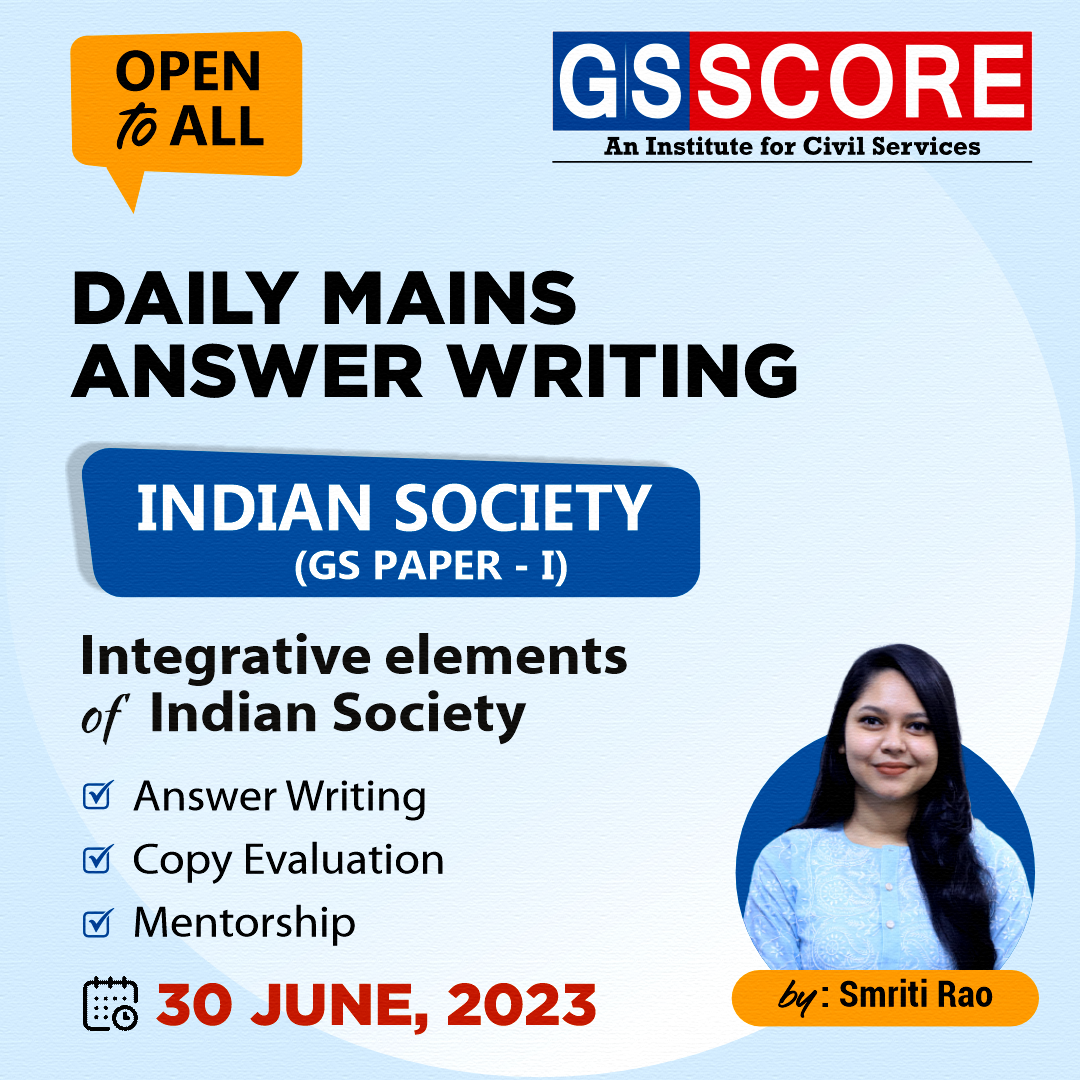


Instruction:
- There will be 2 questions carrying 10 marks each. Write your answers in 150 words
- Any page left blank in the answer-book must be crossed out clearly.
- Evaluated Copy will be re-uploaded on the same thread after 2 days of uploading the copy.
- Discussion of the question and one to one answer improvement session of evaluated copies will be conducted through Google Meet with concerned faculty. You will be informed via mail or SMS for the discussion.
Question #1. “The tradition of accommodation, tolerance and interdependence of Indian society has been in existence in India for long and is still present.” Elaborate.
Question #2. Traditional Indian society has been characterized by holism while individualism has been the hallmark of contemporary India. Elaborate.
(Examiner will pay special attention to the candidate's grasp of his/her material, its relevance to the subject chosen, and to his/ her ability to think constructively and to present his/her ideas concisely, logically and effectively).
STEPS & INSTRUCTIONS for uploading the answers
Step 1 - The Question for the day is provided below these instructions. It will be available at 7:00 AM.
Step 2 - Uploading of Answers : Write the answer in A4 Sheet leaving proper margins for comments and feedback and upload the PDF in MY ACCOUNT section. Click on the option of SUBMIT COPY to upload the PDF.
Step 3 - Deadline for Uploading Answers: The students shall upload their answers by 7:00 PM in the evening same day. The first 50 copies will be evaluated.
Step 4 - Feedback : Mentors will give their feedback for the answers uploaded. For more personalised feedback, join our telegram channel by clicking on the link https://t.me/mains_answer_writing_cse . A one-to-one session will be conducted with the faculty after copy evaluation in 72 Hrs.
Model Answer
Question #1. “The tradition of accommodation, tolerance and interdependence of Indian society has been in existence in India for long and is still present.” Elaborate.
Approach
- Write an introductory paragraph on spirit of accommodation and assimilation features of Indian society. (50 words)
- Explain how the tradition of Interdependence, accommodation and tolerance existed in past and still present in the current times. Explain with the help of examples. (170 words)
- Conclusion (30 words)
Hints:
The spirit of love, tolerance, accommodation and interdependence of Indian society has led to acceptance of various kingdoms and dynasties which came here to rule and it led to assimilation of various cultures. Starting with humanity, people of India are thought of for their humanness. Tolerance played a big part in a traditional Indian society. One understands the different races, beliefs, and practices brought into their country and doesn’t step back and judge.
The spirit and tradition which was present in the past and still exist in the present is strengthening the cause of unity and diversity. Tradition of Interdependence, accommodation and tolerance can be seen in the past and in the present.
Examples of tolerance in the past
- Indo-Aryans came to India their language and culture spread into northwest India around 1500 BCE. They were accepted in the Indian society, their culture got assimilated into our society and it is one of the pillars of our tradition.
- Rise of Buddhism and Jainism because of religious unrest in India in the 6th century B.C. Both were founded on the principle of tolerance, love, accommodation and interdependence. Both religion Buddhism and Jainism and one which was advocated by Vedic period existed side by side.
- Kingdoms like Greeks, Shakas, Hunas and Kushanas were accepted by the Indian society. They brought various cultures which got assimilated into our culture.
- Essence of both Bhakti and Sufi movements dissolved the separate religious identities to a great extent and provides a great contribution to India’s composite culture. It brought to fore the universal brotherhood, equality and oneness of God while rejected castes, rituals, idol worship which promoted the tradition of accommodation and interdependence among various sections of society.
- Different regions of India contributed to promotion of literature and higher learning to the composite culture of India. For example Vedas were developed in Sapta-Sindhu regions, Upanishads in Magadha, Sangam literature in South are shining examples of accommodation of diverse literature in India.
- Though it is believed that India’s continuity as a civilization was social and cultural rather than political; yet idea of bringing entire country under one central authority has been dream of great kings, sultans, emperors and rulers. This idea was put into practice by Chandragupta, Asoka, Harsha, Akbar and British rulers.
- Indian society in the medieval period accepted the rule of Sultanate and Mughals and their culture got assimilated in Indian society forever.
- The tradition of accommodation and interdependence can be seen during the reign of Akbar. Akbar propagated his ideas of tolerance through sulh-i-kul which promoted harmony between various religions. He and other rulers appointed Hindus as their highest military officers.
Even in the present times these traditions are intact
- The Cultural unity in diversity of India is generally denoted with the phrase “Ganga-Jamuni Tahjeeb” or India’s composite culture.
- India has multitude of religions including majority Hinduism and minority Islam, Sikhism, Christianity, Buddhism, Jainism, Zoroastrianism, and Judaism. This diversity has many a times kept the country united in difficult times. Religious unity is particularly visible when a war or a disaster happens. Time and again, India has stood united in crisis, and that is what religious unity in diversity of India is.
- This apart, we see everyday examples of religious harmony such as use of Ganapati Pandal as a makeshift mosque for Muslims and Hindus participating in Eid festivities, Sikhs building mosques for Muslims, Muslims kids robed as Krishna for Janmasthmi festivals and so on.
- Since Independence India have accepted streams of refugees like Tibetians, Tamil refugees from Sri Lanka, Chakma and Hajong refugees which shows the tradition of accommodation.
- Tradition of Interdependence as element of unity in diversity can be seen in rural areas and in joint family structures. One socio-economic activity is linked to the other which is beneficial for both.
- Acceptance of all people whether they are citizens or non-citizens at workplaces like Cinema, music industry etc. - all are accepted and working in harmony.
Conclusion:
Unity in diversity is an important feature of Indian society. Its core idea is “unity without uniformity” and “diversity without fragmentation”. It is based on the notion that diversity enriches human interaction. There are reports from various sources that there is a rise in religious intolerance. But except few incidents, the social fabric of Indian society remains strong.

